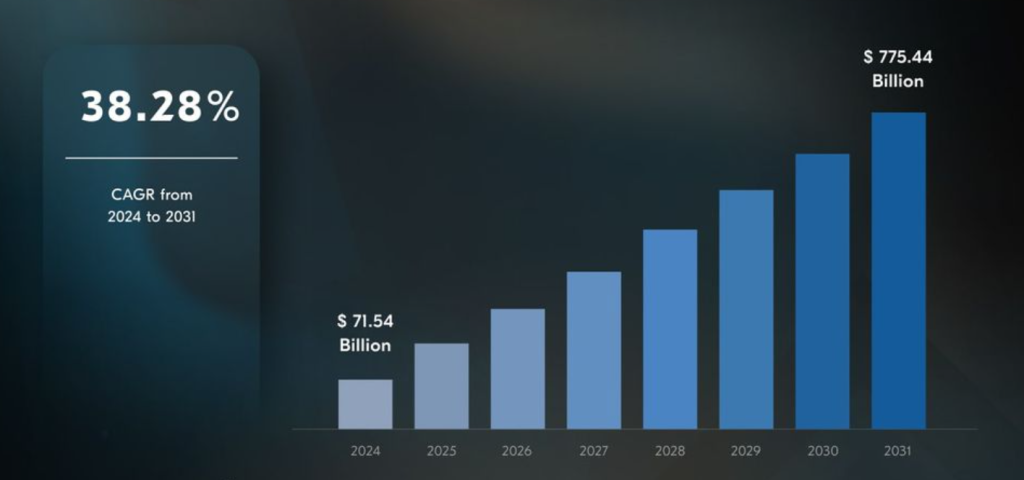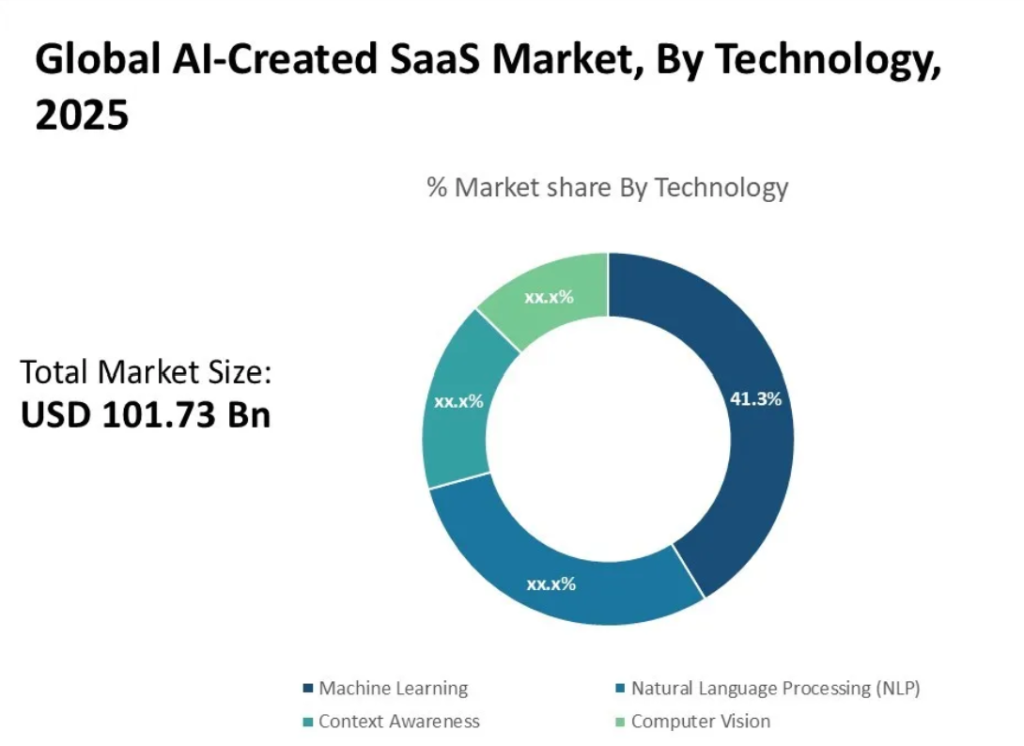- Home
- Fundamentals of Email Marketing
- AI in SaaS: Practical Use Case ...

✨ Key takeaways:
⭐ AI in SaaS allows platforms to adapt to users in real time rather than rely on static rules.
⭐ Hyper-personalization and predictive insights are core benefits of AI-powered SaaS tools.
⭐ Smart automation frees teams from routine tasks and improves overall efficiency.
⭐ AI features should solve real user problems.
⭐ Clean data and transparent AI logic are essential for building user trust.
⭐ Human input remains vital to guide, refine, and direct AI functionality toward business goals.
AI in SaaS is the integration of intelligent, learning-based algorithms into the tools businesses already use every day. And honestly, that’s not surprising. AI is rapidly transforming almost every area of our lives—so, why would SaaS AI be an exception? In fact, if there’s one domain where AI feels not just useful but necessary, it’s this one.
AI SaaS platforms offer something businesses deeply need today without the heavy upfront investment in infrastructure or specialized tech teams. They’re becoming plug-and-play solutions for real problems. As a result, companies can now solve more tasks faster and often with fewer resources. By now, already 35% of SaaS businesses are using AI, and 42% more are planning to do so in the nearest future.
In this article, we’ll explore why AI SaaS tools are gaining traction, where they’re being used most effectively, and how to implement them in a way that delivers real value. Let’s begin!
Why AI in SaaS Matters
The integration of AI in SaaS marks a fundamental shift in how modern platforms operate. From improving user engagement to automating internal workflows, AI-powered SaaS allows systems to adapt, predict, and improve based on user behavior. Below are five core reasons why AI has become an essential part of the SaaS ecosystem.
👉 Hyper-personalization
SaaS AI tools allow platforms to treat users not like data points, but rather like individuals. The implementation of these tools is based on each person’s individual behavior and preferences. The AI system learns what actually works for you—and this learning capability is the main advancement of SaaS AI. By interpreting behavioral signals instead of relying on static user profiles, AI-powered SaaS creates experiences that feel custom-built.
👉 Predictive insights
Based on historical data, AI in SaaS platforms can forecast customer churn, highlight potential upsell opportunities, or identify product usage trends. By providing forward-looking insights, AI SaaS platforms can help teams even before issues occur. With this support, companies can improve business strategies and resource allocation across departments.
👉 Process automation
One of the most common use cases for AI-powered SaaS is automating repetitive tasks. These include tagging data, assigning support tickets, triggering follow-ups, or filtering spam. But what makes AI SaaS tools truly effective is that they also improve the logic behind tasks over time.
👉 Scalable support and self-service
As customer bases grow, maintaining fast and high-quality support becomes more difficult. AI-powered SaaS solutions help by offering scalable support systems such as chatbots, automated responses, and self-service content recommendations. Considering that these systems operate around the clock and continuously learn from user interactions, they can provide more accurate answers over time.
👉 Continuous learning from user behavior
The key advantage of AI in SaaS is that the system evolves through use. Traditional SaaS tools are static and require manual updates. AI SaaS platforms, on the other hand, adapt to changing usage patterns by analyzing user inputs and outcomes. Over time, this allows the platform to adjust its workflows, recommendations, and outputs to better fit actual user needs.
AI in SaaS market growth estimations

AI in SaaS: Key Use Cases
1️⃣ Smart customer support
Customer support is probably one of the most common and visible applications of AI in SaaS. Chatbots and automated assistants can answer frequently asked questions and guide users through product features. Nonetheless, what sets these tools apart is their ability to learn from past conversations and improve future ones based on previous interactions. Over time, they improve support accuracy, reduce ticket volume for human agents, and offer contextual help based on user history.
2️⃣ Marketing and sales optimization
Obviously, marketing and sales teams have much to gain from AI in SaaS, and many already rely on it daily, as SaaS AI tools help teams prioritize actions that are more likely to lead to real results.
As a result of this advancement, marketers can reach the right people with the right message at the right time. This leads to higher engagement, more qualified leads, and better conversion rates across the board. And for sales reps, it means fewer cold calls and more meaningful conversations.
3️⃣ Product experience enhancement
User experience used to be about clean design and intuitive navigation. While it still matters, AI-powered SaaS has introduced an entirely new layer: adaptability. These platforms can now adjust in real time based on how each individual interacts with the product. For example, if a user repeatedly skips a feature, the system might stop highlighting it. This kind of dynamic personalization turns the software into something that feels less like a tool and more like a partner. As a result, users stay longer, explore more, and return more often, which is a massive advantage.
4️⃣ Business intelligence and analytics
Apparently, this is one of the most transformative shifts we’re seeing. The ability to make data-driven decisions is a cornerstone of modern business—and that is another unbeatable advantage of AI for SaaS. AI doesn’t just report what happened—it highlights what matters and, often, what’s likely to happen next. As a result, businesses can move from being reactive to becoming genuinely proactive—adjusting their strategy based on predictive insights.
5️⃣ Operational efficiency
AI-powered SaaS also works behind the scenes of your business by optimizing workflows that usually drain time and resources. These tasks often include automation of invoice approvals or prediction of supply needs. They might not be as flashy as a chatbot or a personalized campaign, but they are just as critical. As a result of these small, cumulative improvements, teams become more focused, and systems in companies run with fewer disruptions. In many cases, this is the kind of invisible efficiency that only becomes noticeable when something doesn’t go wrong.

AI Tools for SaaS Integration
| Area of application | Tools/services | Typical use cases | Industries |
| Language AI | OpenAI, Cohere, Claude, Writer | Used in customer support, content creation, and knowledge base automation | Widely applied in tech, media, education, and e-commerce industries |
| Workflow automation | Zapier AI, Make, n8n | Streamlines tasks between apps and services | Popular in operations, marketing, and small business SaaS environments |
| Analytics & BI | Amplitude, Mixpanel + AI, Tableau GPT | Tracks user behavior, product metrics, and performance insights | Used in product-led companies, SaaS platforms, and finance |
| Search & vector DBs | Pinecone, Weaviate, Redis Vector | Powers semantic search and similarity retrieval | Used in AI search, recommendation systems, and enterprise search engines |
| Custom ML | Vertex AI, AWS SageMaker, Hugging Face | Builds domain-specific ML models and pipelines | Heavily used in research, healthcare, finance, and enterprise AI development |
Best Practices for AI Integration in SaaS
✅ Start with the user problem
The core idea that should sit at the heart of any AI in SaaS effort is not the model itself. You should always begin with a user need. Ask yourself: What kind of problem am I trying to solve here? How can this tool actually help my users? What tasks feel slow, repetitive, or too prone to error?
That’s where your AI SaaS functionality should be directed. It is also where it will matter most. Use AI not as an add-on to what’s already working, but as a tool to eliminate what’s not. The closer your AI aligns with real user pain points, the more naturally it will fit into your product and the more likely users will benefit from it.
✅ Choose build vs. buy wisely
Not every team needs to build their own AI models from scratch. If speed and scalability are priorities (which they often are), using pre-trained APIs like OpenAI or Cohere can get you started much faster. These SaaS AI tools come with advanced capabilities, and they’re flexible enough to be integrated into a variety of workflows.
That said, there are moments when building something custom is the smarter path. If you’re dealing with highly specific industry data, if data privacy is a concern, or if your AI functionality is at the core of your product vision, a custom model might serve you better. Whichever choice you make, the AI SaaS platforms should be built with your long-term goal in mind.
✅ Invest in data quality early
AI in SaaS is only as good as the data behind it. If your inputs are messy, biased, or inconsistent, your outputs will reflect that—no matter how advanced the model is.
So, start early by collecting clean, structured data: they provide foundational input for your AI-powered SaaS system. By integrating good data habits into your process from the start, you make sure to avoid critical mistakes at a later point.
✅ Make AI transparent and trustworthy
When a user doesn’t understand how something works, they’re less likely to trust it—no matter how helpful it might be. That’s why transparency is essential in any AI SaaS platform. So, let users know that a result was AI-generated and allow users to adjust, override, or dismiss suggestions. Apparently, when people feel in control, they’re more willing to engage.
✅ Measure what actually matters
The most important aspect to remember when it comes to measuring your progress with AI is that metrics should be tied to value, not vanity. While it is tempting to track how often a button was clicked—that doesn’t tell you if it helped. Instead, ask questions like: Are users saving time? Are support tickets going down? Did conversions go up after you launched that new feature with AI in SaaS? These questions are related to efficiency, retention, and problem resolution—aspects that help your business long-term.

To Sum Up
AI in SaaS is a powerful shift that’s already reshaping the way businesses operate. They free up human teams from the mundane and let them focus on the meaningful. But here’s the thing: while AI in SaaS can handle a lot, it can’t replace thoughtful human input. The real work lies in knowing exactly what problem you’re trying to solve and feeding your AI the right data. Because if your core assumptions are off, then even the most advanced AI won’t do your business much good. In fact, it could lead you in the wrong direction.
So yes, AI in SaaS is about automation—but it’s also about co-creation. The AI does the heavy lifting, but it’s humans who still set the direction, frame the goals, and make sure the tool is serving a real, valuable purpose.



